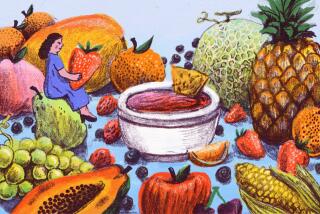Exotic Taste of Peru : The county is a main U.S. source for the sweet, odd-looking fruit. But growers still feel the sting from last year’s freeze.
- Share via
When a troublesome disease started obliterating avocado trees in the area about 20 years ago, some growers went in search of alternative crops to replace their lost bounty.
“We were looking for something that wouldn’t be affected by the root rot problem,” said Ventura County farmer Scott Van Der Kar.
Ultimately, Van Der Kar and others came across a crop that was resistant to the disease and provided a monetary return similar to the lucrative avocado.
It was a little-known, odd-looking fruit native to the highlands of Peru and Ecuador--the cherimoya.
Part of the attraction of the cherimoya is its unique flavor, which has been likened to an exotic blend of papaya, pineapple and banana.
On small acreage along the coastal belt, about 20 Ventura County growers raise the fruit, which is being harvested through May.
The cherimoya is about the size of a large orange and has a sweet creamy, custard-like flesh veiled by a delicate, greenish skin. Its hand grenade texture distinguishes the cherimoya from other fruit.
Van Der Kar has grown cherimoyas since the late 1970s in a tiny orchard near Rincon Canyon. “We’re experimenting as we go along,” he said. The return can be as good as avocados--barring weather problems.”
Last year’s big freeze was detrimental. “We’re still recovering,” Van Der Kar said.
Production from the Ventura County, Carpinteria and Santa Barbara areas continues to be low because some trees are still recovering from freeze damage. A large-volume loss can be devastating, considering that area growers harvest most of the cherimoyas consumed in the United States.
According to Peter Nichols of California Tropics in Carpinteria, about 70% of the cherimoyas grown in the United States come from this area.
California Tropics farms about 35 acres of the subtropical fruit and packs for a number of Ventura County growers. The family-owned business annually ships more than 1 million pounds of cherimoyas across the United States and abroad.
“Altogether we draw fruit from about 150 acres,” said Nichols. That makes this area one of the largest cherimoya production centers in the world. The leaders are Spain and South America.
Shoppers will probably find cherimoyas at area farmers’ markets, including those in Carpinteria and Santa Barbara. “It’s mostly sold to upscale supermarkets across the U.S.,” Nichols said. He suggested Vons, Lucky food centers and gourmet markets such as Gelson’s Market or Mrs. Gooch’s Natural Foods Markets.
Even though popularity is expected to grow as more consumers discover the fruit, Nichols said farmers won’t be rushing to convert their land to cherimoya orchards.
“It will remain limited because of the extreme labor involved and foreign competition,” he said.
Van Der Kar said yellow blossoms begin in an immature stage, develop to female and 24 hours later to male. “Each is a complete flower,” he said.
Male blossoms are gently brushed with a small paintbrush, and pollen is collected in a tiny canister. “When we find a flower in the female stage,” he said, “we slide the (pollen-laden) brush into the receptive portion of the petals. We play the role of being the bees because they aren’t attracted to the flower,” Van Der Kar said. “The tree will self-pollinate but only in a hit-or-miss manner. The need is to get a reliable crop.”
Another method involves using a small air-gun device in which the pollen is blown into the female flowers.
It is not odd that the plant flowers like this, he said. “Avocados flower in this manner,” he explained. “But most plants that do, have an overlap period when they are both male and female for a sufficient period of time. It enables the plant to pollinate itself.” Cherimoyas do not have this overlap period, Van Der Kar said.
The hands-on treatment commands premium prices at the market. Van Der Kar said the fruit is sold wholesale from $1 to $3 per pound. “Retail can be twice that.”
Nichols suggested that shoppers select cherimoyas that are firm and light yellowish-green. “You want to ripen it at home,” he said. Allow it to ripen at room temperature. Ripe fruit becomes a duller green.
Cherimoya, Nichols said, blends well with most varieties of fruit for salads and can be used for such desserts as sorbet and parfait.
SERVING SUGGESTION / CHERIMOYA SORBET
1/2 cup sugar
3/4 cup water
1 envelope unflavored gelatin
2 tablespoons cold water
2 tablespoons Curacao
1 tablespoon lime juice
1/2 cup orange juice
2 cups Cherimoya puree
2 egg whites
In a small saucepan, combine sugar and 3/4 cup water; bring to boil, simmer 5 minutes. Sprinkle gelatin into 2 tablespoons cold water, let stand 1 minute; stir into hot sugar syrup. Cool slightly and add Curacao, lime, orange juice and Cherimoya puree; blend. Pour into 2 ice cube trays and freeze until mushy. Turn into chilled mixer bowl; add unbeaten egg whites, beat until light and fluffy. Return to freezer trays and freeze until firm 4 to 6 hours. Makes 6 servings.
More to Read
Eat your way across L.A.
Get our weekly Tasting Notes newsletter for reviews, news and more.
You may occasionally receive promotional content from the Los Angeles Times.









